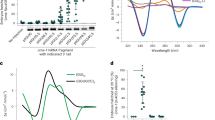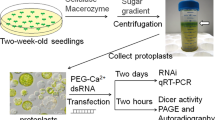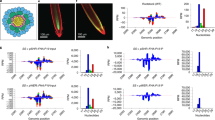Abstract
RNA interference (RNAi) is the mechanism through which double-stranded RNAs silence cognate genes1,2,3,4,5. In plants, this can occur at both the transcriptional and the post-transcriptional levels1,2,5; however, in animals, only post-transcriptional RNAi has been reported to date. In both plants and animals, RNAi is characterized by the presence of RNAs of about 22 nucleotides in length that are homologous to the gene that is being suppressed6,7,8. These 22-nucleotide sequences serve as guide sequences that instruct a multicomponent nuclease, RISC, to destroy specific messenger RNAs6. Here we identify an enzyme, Dicer, which can produce putative guide RNAs. Dicer is a member of the RNase III family of nucleases that specifically cleave double-stranded RNAs, and is evolutionarily conserved in worms, flies, plants, fungi and mammals. The enzyme has a distinctive structure, which includes a helicase domain and dual RNase III motifs. Dicer also contains a region of homology to the RDE1/QDE2/ARGONAUTE family that has been genetically linked to RNAi9,10.
This is a preview of subscription content, access via your institution
Access options
Subscribe to this journal
Receive 51 print issues and online access
$199.00 per year
only $3.90 per issue
Buy this article
- Purchase on Springer Link
- Instant access to full article PDF
Prices may be subject to local taxes which are calculated during checkout



Similar content being viewed by others
References
Baulcombe, D. C. RNA as a target and an initiator of post-transcriptional gene silencing in transgenic plants. Plant Mol. Biol. 32, 79–88 (1996).
Wassenegger, M. & Pelissier, T. A model for RNA-mediated gene silencing in higher plants. Plant Mol. Biol. 37, 349–62 ( 1998).
Montgomery, M. K. & Fire, A. Double-stranded RNA as a mediator in sequence-specific genetic silencing and co-suppression. Trends Genet. 14, 255–258 (1998).
Sharp, P. A. RNAi and double-strand RNA. Genes Dev. 13, 139–141 (1999).
Sijen, T. & Kooter, J. M. Post-transcriptional gene-silencing: RNAs on the attack or on the defense? BioEssays 22, 520–531 (2000).
Hammond, S. M., Bernstein, E., Beach, D. & Hannon, G. J. An RNA-directed nuclease mediates post-transcriptional gene silencing in Drosophila cells. Nature 404, 293– 296 (2000).
Hamilton, A. J. & Baulcombe, D. C. A species of small antisense RNA in posttranscriptional gene silencing in plants. Science 286, 950–952 ( 1999).
Zamore, P. D., Tuschl, T., Sharp, P. A. & Bartel, D. P. RNAi: double-stranded RNA directs the ATP-dependent cleavage of mRNA at 21 to 23 nucleotide intervals. Cell 101, 25–33 (2000).
Tabara, H. et al. The rde-1 gene, RNA interference, and transposon silencing in C. elegans. Cell 99, 123– 132 (1999).
Catalanotto, C., Azzalin, G., Macino, G. & Cogoni, C. Gene silencing in worms and fungi. Nature 404, 245 (2000).
Tuschl, T., Zamore, P. D., Lehmann, R., Bartel, D. P. & Sharp, P. A. Targeted mRNA degradation by double-stranded RNA in vitro. Genes Dev. 13, 3191 –3197 (1999).
Nicholson, A. W. Function, mechanism and regulation of bacterial ribonucleases. FEMS Microbiol. Rev. 23, 371–390 (1999).
Filippov, V., Solovyev, V., Filippova, M. & Gill, S. S. A novel type of RNase III family proteins in eukaryotes. Gene 245, 213–221 (2000).
Bass, B. L. Double-stranded RNA as a template for gene silencing. Cell 101, 235–238 (2000).
Gillespie, D. E. & Berg, C. A. Homeless is required for RNA localization in Drosophila oogenesis and encodes a new member of the DE-H family of RNA-dependent ATPases. Genes Dev. 9, 2495–2508 (1995).
Jacobsen, S. E., Running, M. P. & Meyerowitz, E. M. Disruption of an RNA helicase/RNAse III gene in Arabidopsis causes unregulated cell division in floral meristems. Development 126, 5231–5243 (1999).
Matsuda, S. et al. Molecular cloning and characterization of a novel human gene (HERNA) which encodes a putative RNA-helicase. Biochim. Biophys. Acta 1490, 163–169 ( 2000).
Wianny, F. & Zernicka-Goetz, M. Specific interference with gene function by double-stranded RNA in early mouse development. Nature Cell Biol. 2, 70–75 (2000).
Sonnhammer, E. L., Eddy, S. R. & Durbin, R. Pfam: a comprehensive database of protein domain families based on seed alignments. Proteins Struct. Funct. Genet. 28, 405–420 (1997).
Cerutti, L., Mian, N. & Bateman, A. Domains in gene silencing and cell differentiation proteins: the novel PAZ domain and redefinition of the Piwi domain. Trends Biochem. Sci. 25, 481–482 (2000).
Bohmert, K. et al. AGO1 defines a novel locus of Arabidopsis controlling leaf development. EMBO J. 17, 170– 180 (1998).
Yang, D., Lu, H. & Erickson, J. W. Evidence that processed small dsRNAs may mediate sequence-specific mRNA degradation during RNAi in Drosophila embryos. Curr. Biol. 10, 1191–1200 ( 2000).
Fagard, M., Bouter, S., Morel, J. B., Bellini, C. & Vaucheret, H. AGO1, QDE-2, and RDE-1 are related proteins required for post-transcriptional gene silencing in plants, quelling in fungi, and RNA interference in animals. Proc. Natl Acad. Sci. USA 97, 11650–11654 (2000).
Acknowledgements
We thank A. Nicholson for his gift of purified RNase III, and P. Fisher, M. McConnel and M. Pang for providing aid and materials for large-scale fly embryo culture. The Homeless clone was a gift from D. E. Gillespie and C. A. Berg. We also thank R. Kobayashi and R. Martiennsen for discussion and critical reading of the manuscript, and K. Velinzon for FACS. A.A.C. is an Anderson Fellow of the Watson School of Biological Sciences and a Predoctoral Fellow of the Howard Hughes Medical Institute. S.M.H. is a visiting scientist from Genetica, (Cambridge, MA). G.J.H. is a Pew Scholar in the biomedical sciences. This work was supported in part by grants from the NIH (G.J.H.).
Author information
Authors and Affiliations
Supplementary information
Rights and permissions
About this article
Cite this article
Bernstein, E., Caudy, A., Hammond, S. et al. Role for a bidentate ribonuclease in the initiation step of RNA interference . Nature 409, 363–366 (2001). https://doi.org/10.1038/35053110
Received:
Accepted:
Issue Date:
DOI: https://doi.org/10.1038/35053110
This article is cited by
-
microRNA-622 upregulates cell cycle process by targeting FOLR2 to promote CRC proliferation
BMC Cancer (2024)
-
Immunoinformatic and molecular docking approaches: siRNA prediction to silence cell surface binding protein of monkeypox virus
Beni-Suef University Journal of Basic and Applied Sciences (2024)
-
The impact of substrate stiffness on morphological, transcriptional and functional aspects in RPE
Scientific Reports (2024)
-
Death Induced by Survival gene Elimination (DISE) correlates with neurotoxicity in Alzheimer’s disease and aging
Nature Communications (2024)
-
HRDE-2 drives small RNA specificity for the nuclear Argonaute protein HRDE-1
Nature Communications (2024)
Comments
By submitting a comment you agree to abide by our Terms and Community Guidelines. If you find something abusive or that does not comply with our terms or guidelines please flag it as inappropriate.



